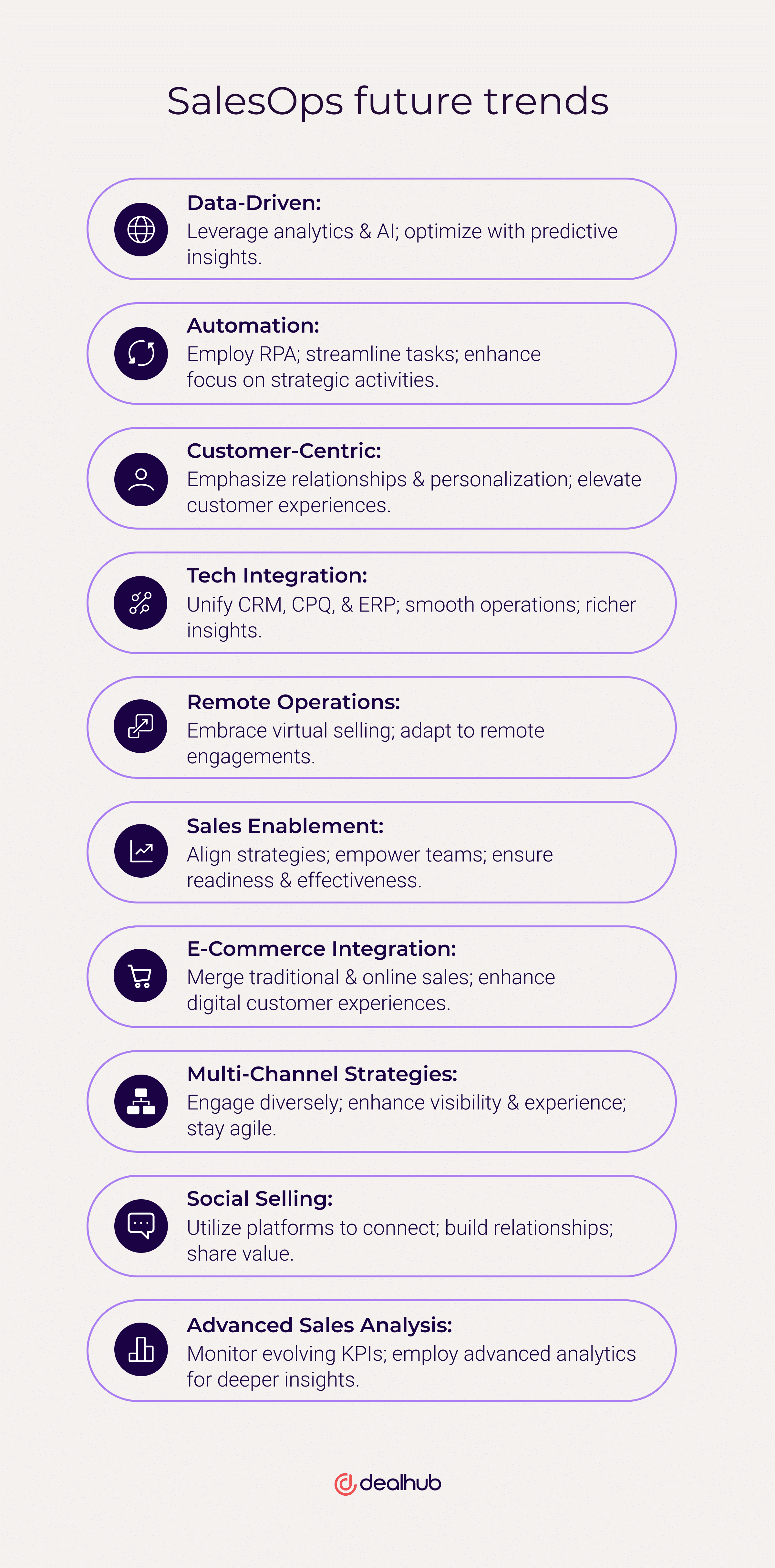Dive deep with us into the vibrant and ever-changing world of SalesOps in this comprehensive blog. We’re exploring groundbreaking strategies, cutting-edge technologies, and innovative methodologies set to reshape the landscape in the years to come. Ready to uncover the future of SalesOps? Join us on this exciting journey, arm yourself with invaluable insights, and gear up your organization for unparalleled success!
SalesOps trends shaping the future of sales
SalesOps is at the forefront of a data-driven revolution. It’s all about leveraging big data and AI algorithms to analyze sales data and make precise forecasts for better decision-making and strategizing. If you want to gain a toehold in the market and build a more robust sales approach, then consider these ten significant SalesOps trends leading the way:

Data-driven decision-making
With an increasing reliance on analytics and artificial intelligence, sales operations are elevating their decision-making processes. Sales teams are leveraging data to discern customer preferences and anticipate buying behaviors, optimizing sales processes effectively. Tools like predictive analytics for sales forecasting and predictive lead scoring, along with AI and machine learning for sales data analysis, are becoming indispensable.
Furthermore, SalesOps is employing predictive analytics to assess and prioritize leads effectively. By scrutinizing historical data and patterns in customer behavior, companies can pinpoint the most lucrative leads. This enables a more efficient allocation of resources, thereby saving both time and money.
Sales process automation
Automation has become ubiquitous across every organization’s operations, and SalesOps is no different. The most effective SalesOps teams are streamlining routine tasks with automation, and Robotic Process Automation (RPA) has become a game-changer in this regard. By reducing manual processes (and removing the likelihood of human error), SalesOps teams can enhance productivity and focus on more strategic activities.
Marketing automation tools, including chatbots, email marketing automation, and CRM systems, are streamlining these repetitive tasks, allowing sales teams to focus on more strategic activities. This trend is expected to continue with more advanced AI-driven automation.
Customer-centric approach to sales
As sales representatives recoup time spent on admin, their focus shifts to more critical endeavors – such as building relationships with prospects and existing customers. This is a net gain for revenue, as 61% of consumers are willing pay at least 5% more if they know they’ll have a good customer experience. Personalization and tailored sales strategies are vital to enhancing customer experiences through SalesOps. In the future, focusing more on the customer will assist in building long-lasting customer relationships.
Integration of sales technologies
CRM, CPQ, and ERP systems are the backbone of SalesOps. Integrating these technologies into an organization’s tech stack is crucial to creating a unified sales ecosystem that enables smoother operations and better insights. With data compiled across platforms, SaleOps can better understand what’s working, what’s not, and where revenue opportunities lie.
Remote sales operations
The COVID-19 pandemic accelerated the shift towards remote work and virtual selling. These days, it’s typical for sales operations to adapt to new ways of engaging with clients, such as virtual meetings, webinars, and online demons. Remote sales operations are not going anywhere. In fact, according to McKinsey, 90% of organizations have embraced a variety of hybrid work models. Even as the pandemic wanes, virtual selling will likely remain a significant part of the sales landscape.
SalesOps and sales enablement
Sales enablement represents a contemporary strategic approach within an organization, concentrating on equipping the sales team with:
- Content and materials (sales collateral, presentations, case studies, etc.)
- Ongoing training and development opportunities
- Technology and tools (CRMs, sales automation software, analytics, etc.)
- Collaboration and communication between teams (including marketing, sales, product development, customer success, finance etc.)
- Customer insights
All these strategies are designed to enable sales representatives to sell more efficiently. Aligning with sales enablement strategies is empowering sales teams, ensuring they are ready and effective in their sales endeavors.
E-commerce integration
Merging e-commerce channels with traditional sales avenues is more than just a necessity; it’s a gateway to untapped possibilities! By tapping into online marketplaces, sprucing up digital storefronts, and rolling out online self-service options, companies are opening doors to an enhanced customer experience. In an era driven by digital evolution, such integration is not just crucial – it’s a golden ticket to meeting, and even surpassing, the ever-evolving expectations of today’s savvy customers. Dive into the digital wave and watch your customer satisfaction soar!
Multi-channel sales strategies
Taking engagement to the next level, sales operations are weaving multi-channel strategies into their tapestry, aiming to connect with customers wherever they wander. This means delving into both online and offline realms, sparking conversations through emails, social media, phone calls, and even good old face-to-face interactions. Why? Because multi-channel sales strategies aren’t just practical—they’re a game-changer, allowing sales to:
Reach a diverse audience. Different customers have different preferences and online habits.
Increase visibility. A prospect or customer is likelier to notice a brand if they see it on multiple channels, and a brand has more potential to reach more customers if it covers more channels.
Enhance the customer experience (to make outreach more personal). For example, a customer who starts a conversation on a web chat can easily transition to phone or email to ensure a tailored experience.
Remain agile. Multi-channel strategies allow SalesOps to adapt to changing circumstances. For example, during COVID-19, businesses with diverse communication channels could pivot quickly to remote sales and virtual selling, ensuring business continuity.
Improve engagement. Engaging customers through various channels enables sales teams to nurture leads, address inquiries, and share information about new products or promotions.
Social selling
Sales professionals leverage social media platforms to connect with potential customers, share valuable content, and build relationships. These days, 56% of sales representatives leverage social media to find new prospects. Social selling involves using platforms like LinkedIn and Facebook to engage with prospects in a more personalized way. Building trust and credibility through social media can significantly impact sales success.
Sales analysis
Key Performance Indicators (KPIs) are evolving to meet the changing landscape of SalesOps. Measuring the effectiveness of SalesOps and benchmarking against industry standards are crucial for continuous improvement. In the future, advanced analytics and AI will play a more prominent role in sales analysis, providing deeper insights for better decision-making.
Modern SalesOps teams should keep an eye on:
- Lead-to-Customer Conversion Rate: This KPI measures the percentage of leads that go through the sales funnel and ultimately become customers. It evaluates lead quality and the efficiency of the sales process.
- Sales Cycle Length: This metric calculates the average time it takes for a lead to move through the sales funnel and become a customer. Reducing the sales cycle length can lead to more efficient sales operations.
- Win Rate: Win rate calculates the percentage of sales opportunities the sales team successfully closes. It provides insights into the team’s ability to convert leads into customers.
- Customer Satisfaction (CSAT) Score: CSAT measures customer satisfaction based on feedback and surveys. It provides insights into how well the sales and customer service teams meet customer expectations.
- Net Promoter Score (NPS): NPS measures customer loyalty and willingness to recommend the company to others. A high NPS indicates strong customer advocacy.
- Average Deal Size: This KPI calculates the average value of each sale. It is crucial for understanding the typical size of transactions and can inform pricing and sales strategies.
- Sales Pipeline Value: The total value of all deals currently in the sales pipeline provides insights into the potential revenue the sales team is working to close.
Future-proofing your SalesOps
To future-proof your organization, it’s essential to acknowledge and address the challenges of emerging sales operations trends. After all, adapting to rapid changes in the sales landscape requires an agile SalesOps strategy and long-term planning for sustainability.
Typical challenges SaleOps teams must overcome include:
- Resistance to change. Sales representatives can get set in their ways and resist adopting new strategies or technologies.
- Lack of training. Organizations that don’t invest in fully training their teams and filling skills gaps can slow down process adoption and hinder SalesOps effectiveness.
- Misalignment with current sales processes and workflows can disrupt operations and cause inefficiencies.
SaleOps leaders can overcome these hurdles by encouraging communication and transparency. By addressing concerns head-on and showcasing the upside of embracing the latest trends (like automation and data analysis), Sales Ops leaders can illustrate how trends can enhance the customer experience, streamline the sales representative’s workload, and accelerate the sales pipeline.
Embracing change
The future of SalesOps is an exciting and dynamic landscape. In response to these emerging trends, SalesOps professionals will need to continuously adapt and innovate, embracing new technologies and methodologies to drive sales efficiency and effectiveness while navigating an increasingly complex sales landscape.
As you embark on this journey to shape the future of your SalesOps, remember that staying ahead of these emerging trends will keep your organization competitive and position it as a leader in the world of sales. Embrace change with open arms, and watch your SalesOps soar to new heights. The future is bright, and you can be at the forefront of SalesOps excellence by embracing the right strategies.





